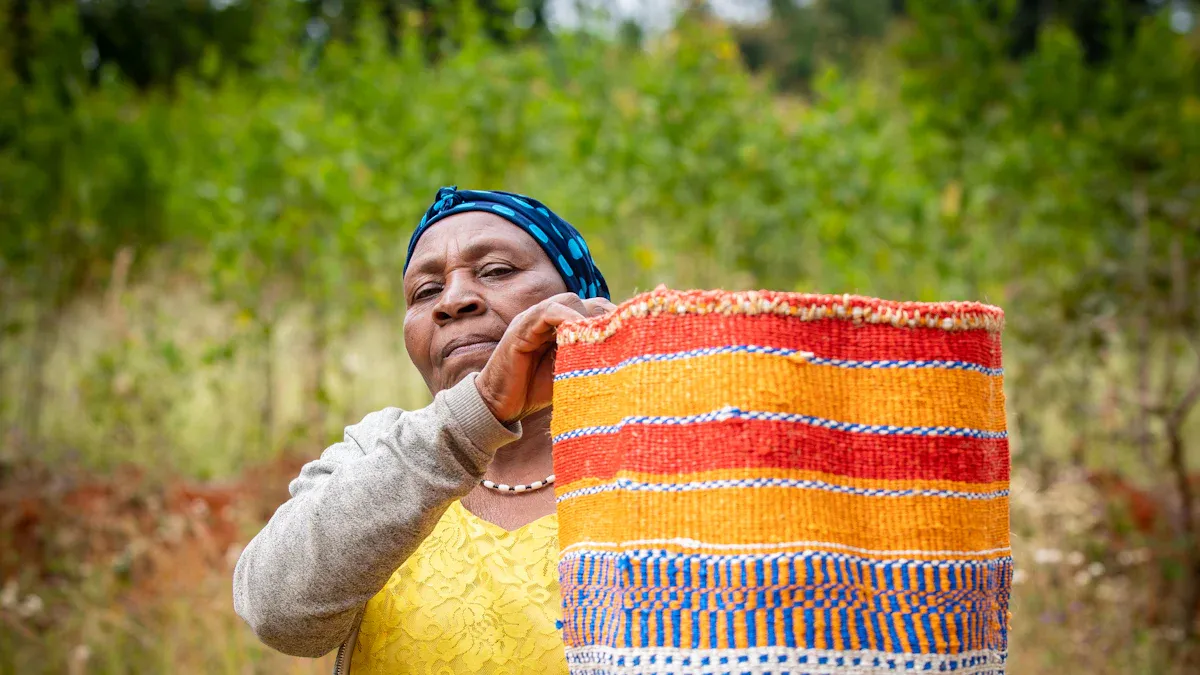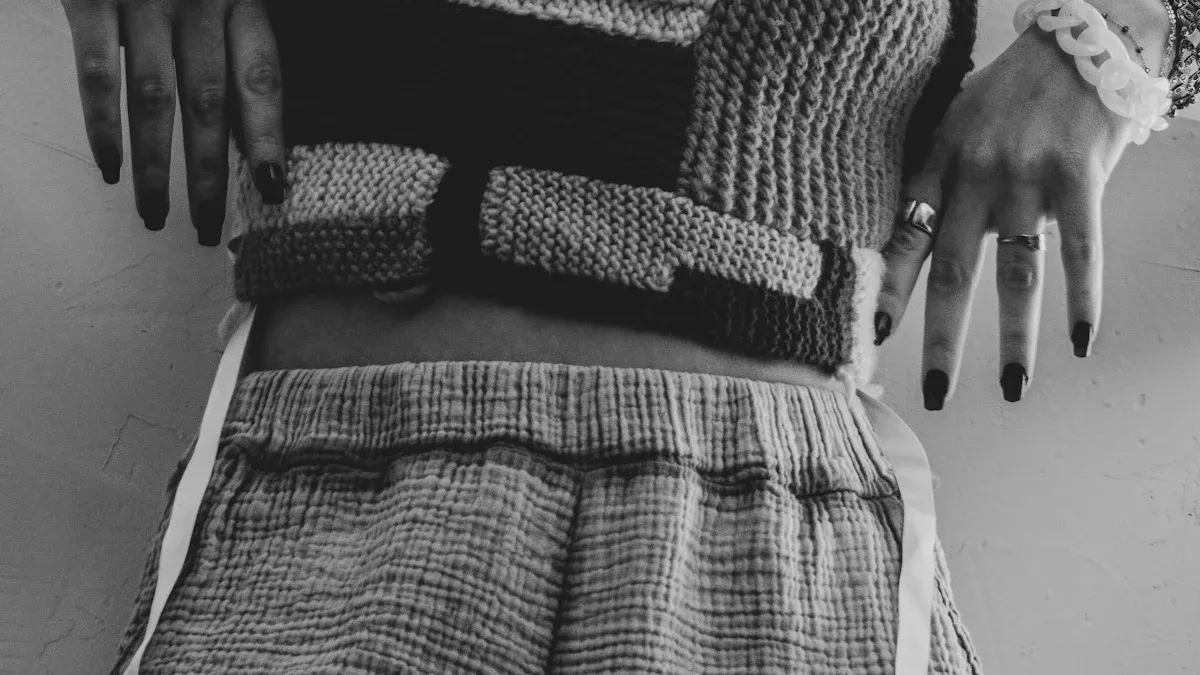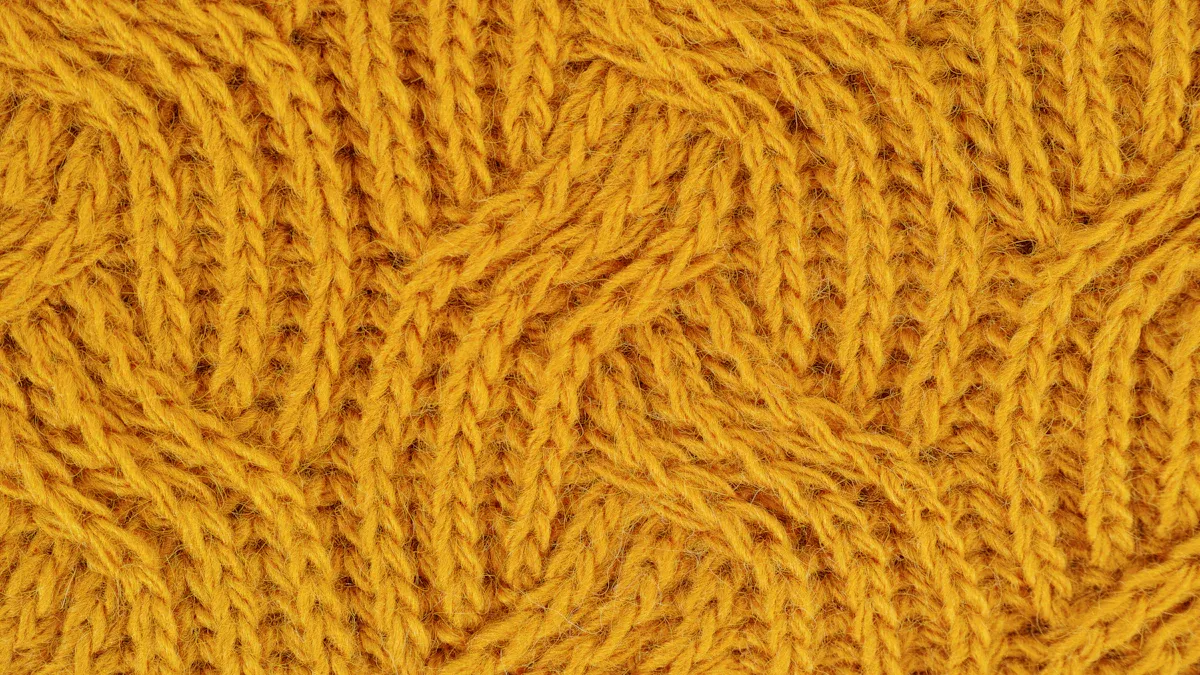
Do you want to add more creativity to your knitting? The knitting belt brings together both traditional and modern techniques. People in Shetland, Scotland, have relied on the knitting belt for generations. It supports their hands and helps them knit faster. The makkin belt, a type of knitting belt, is crafted from leather and horsehair. It allowed knitters to work quickly and with less fatigue.
Knitting connects you to a rich history. Archaeologists have discovered early evidence of knitting in Turkey and Georgia. Shetland knitters still use their knitting belt today.
Shetland’s makkin belt, a classic knitting belt, holds double-pointed needles.
Some believe Shetland women introduced the knitting belt to other regions when they traveled for work.
Knitting has evolved a lot over the years. Here are some recent trends:
Aspect | Statistic / Insight |
|---|---|
Global Search Interest (2008-2023) | |
Global Search Interest (2022-2023) | 1% drop in growth over 1 year |
Pandemic Impact | Lion Brand saw 80% more sales since lockdowns |
Social Media Presence | Over 23 million Instagram posts use the #knitting hashtag |

Using a knitting belt can improve your posture and help you knit faster, all while adding a touch of style. With a knitting belt, you can express your creativity in every project. Try new techniques, make your work unique, and inspire others with your creations. This year, let your knitting—and your knitting belt—showcase your personal style and passion.
Key Takeaways
A knitting belt helps you feel better and sit up straight. It supports your hands and lowers pain in your wrists and shoulders.
Knitting belts let you knit faster and use less energy. They keep your needles steady and help your hands move less.
You can try many knitting belt designs like classic cables, boho fringe, colorwork, and lacy openwork. These styles let you show your creativity.
Cotton yarn is a good pick for knitting belts. It feels soft, keeps its shape, and fits many patterns.
Pick knitting projects that fit your skill and style. This helps you enjoy knitting and make special gifts that last.
Knitting Belt Benefits

Posture & Comfort
You deserve comfort while you knit. The knitting belt offers more than tradition. It gives you a way to support your hands and body. When you use a knitting belt, you hold your needles steady. Your right hand and arm move less. This means your wrists stay relaxed. You avoid tension in your shoulders and neck. Many knitters say they can work for hours without feeling tired. You can adjust the belt’s position and needle angle to fit your body. This helps you avoid headaches and strain.
Here are some ways a knitting belt supports your comfort:
Minimizes motion, so you waste less energy.
Reduces the risk of repetitive motion stress, like carpal tunnel syndrome.
Keeps your elbows at a comfortable angle, about 90 degrees.
Lets you knit longer without fatigue or pain.
Helps you avoid wrist strain and tension headaches.
You can enjoy knitting more when your body feels good. The knitting belt makes this possible.
Efficiency in Knitting
You want to finish projects faster and with less effort. The knitting belt helps you do just that. Many knitters notice a big boost in speed when they use this tool. At a knitting event, Stephanie amazed everyone by knitting while walking around the room. Her hands moved quickly and smoothly. People could not believe how fast she worked. Hazel Tindall, known as the world’s fastest knitter, also uses a knitting belt for her record-breaking speed.
When you use a knitting belt, you only need small movements to make each stitch. This saves time and energy. Janette Budge shares that the belt keeps your needles stable. Your wrists and arms do not get tired as quickly. Shetland knitters have relied on this method for generations. They needed to knit quickly to support their families. Today, you can use the same technique to knit more efficiently and enjoy longer, more productive sessions.
Creative Knitting Designs

Classic Cable
You can never go wrong with a classic cable belt. This design comes from the Aran Islands, where fishermen needed warmth and durability. The twisted rope-like patterns give your belt a rich texture and a timeless look. You will love how the raised cables add both style and insulation. Many knitters choose wool or cotton for these projects because they last and feel comfortable.
The cable design stands out for several reasons:
It offers warmth and durability.
The patterns look intricate and unique.
Cable belts keep their shape over time.
You can wear them with almost any outfit.
Tip: Try using cotton yarn for a lighter, summer-friendly version. Add a wooden button or a metal buckle for extra flair.
Boho Fringe
Bring out your free spirit with a boho fringe belt. This style uses simple stitches and adds long, flowing fringe at the ends. You can use bright cotton yarns to create a playful, festival-ready accessory. The fringe moves as you walk, making every outfit more fun.
You can personalize your belt by adding beads or shells to the fringe. This design lets you show off your creativity and makes every belt one-of-a-kind.
Tip: Mix different cotton colors for a rainbow effect. Secure the fringe tightly so it stays in place during all your adventures.
Colorwork Patterns
Colorwork patterns let you play with bold designs and striking contrasts. Mosaic knitting and the Cartridge Belt Rib Stitch both create eye-catching effects. Mosaic knitting uses slipped stitches and two colors to form intricate patterns without juggling many yarns. The Cartridge Belt Rib Stitch gives your belt deep ridges and a strong structure.
Choose cotton yarns with high contrast, like navy and white or red and yellow. This makes your patterns pop and gives your belt a modern twist.
Tip: Follow a simple chart for your first colorwork project. Try adding a zipper or snap for easy fastening and extra style.
Seed Stitch Texture
Seed stitch gives your belt a bumpy, textured look that feels great to touch. This stitch lies flat and does not curl, so your belt always looks neat. You can use seed stitch on both sides, which is perfect for belts that twist or flip. Even if you are new to knitting, you can master this stitch with just knit and purl.
Seed stitch works well with cotton yarn, making your belt soft and sturdy. The classic look fits any wardrobe and adds a touch of elegance to your creative projects.
Tip: Try a two-tone seed stitch for extra visual interest. Add a decorative button for a personal touch.
Lacy Openwork
Lacy openwork belts bring a delicate, airy feel to your outfits. You can use simple yarn overs and decreases to create beautiful patterns that look like flowers or vines. Cotton yarn is perfect for this style because it holds the shape of the lace and feels cool against your skin.
You can wear a lacy belt over dresses or tunics for a light, feminine accent. Add a small metal clasp or a ribbon tie for a custom finish.
Tip: Block your finished belt to open up the lace and show off the pattern. Try using pastel cotton for a soft, romantic look.
Double Knit Belt
A double knit belt gives you strength and flexibility. This technique creates two layers at once, making your belt thick and sturdy. Both sides look great, so you can wear it either way. The fabric resists stretching and keeps its shape, even after many wears.
Double knitting offers these benefits:
Two layers for extra durability.
Reversible patterns for more style options.
Clean edges and a smooth finish.
Long-lasting structure for daily use.
You can use cotton for a soft, washable double knit belt. Try adding a bold pattern on one side and a solid color on the other for more customisation and creativity.
Tip: Start with a simple double knit belt pattern if you are new to this technique. Use a magnetic clasp for a modern touch.
Beaded Embellishments
Beads turn a simple belt into a statement piece. You can use glass, plastic, metal, crystal, or pearl beads to match your style. Small beads add a subtle sparkle, while large beads make your belt bold and eye-catching. Choose colors that fit your mood—neutral for classic looks, metallic for glamour, or bright for fun.
Bead Type | Best For | Look & Feel |
|---|---|---|
Glass | Formal, elegant | Shiny, vibrant |
Plastic | Everyday, playful | Lightweight, durable |
Metal | Modern, edgy | Strong, sleek |
Crystal | Luxury, special events | Sparkling, delicate |
Pearl | Bridal, timeless | Soft, classic |
You can sew beads onto cotton belts or string them onto fringe for extra detail. This is a great way to express your creativity and make your creative projects stand out.
Tip: Use medium-sized beads for a balanced look. Try mixing bead shapes for more texture.
Upcycled Yarn
Upcycled yarn helps you care for the planet while you knit. You can unravel old sweaters or use leftover yarn from other projects. This keeps materials out of landfills and saves resources. Upcycled cotton yarn works well for belts, giving you a soft, eco-friendly option.
Benefits of upcycled yarn:
Reduces waste and saves resources.
Keeps old yarn in use.
Lets you mix colors and textures for unique patterns.
Supports sustainable creative projects.
Tip: Combine different cotton yarns for a patchwork effect. Add a recycled buckle for a fully upcycled belt.
Chunky Style
Chunky belts make a bold statement. Use bulky or super bulky yarn with large needles to create thick, cozy belts. Cotton yarn in a chunky weight feels soft and adds structure. These belts work well over sweaters or coats and keep their shape all day.
Choose needle sizes from 5.5 mm to 8.0 mm for bulky yarn, or go even bigger for jumbo yarn. Chunky belts knit up quickly, so you can finish your projects fast.
Tip: Add a big wooden button or a bright buckle for extra impact. Try a simple stitch pattern to let the chunky yarn shine.
Minimalist I-Cord
Minimalist I-cord belts offer a sleek, modern look. The tubular shape feels smooth and comfortable. You can adjust the thickness by changing the number of stitches. Cotton I-cords are strong and do not dig into your waist or shoulders.
I-cord features:
Tubular and seamless.
Customizable in length and thickness.
Works as a belt, strap, or drawstring.
Simple but stylish for any outfit.
You can personalize your I-cord belt with a knot, a small charm, or a simple clasp. This design proves that less can be more in your creative projects.
Tip: Try a three-stitch I-cord for a classic look. Use bright cotton yarn for a pop of color.
Knitting with Cotton Yarn
Cotton Belt Ideas
Knitting with cotton yarn opens up a world of possibilities for your creative projects. Cotton feels soft against your skin and stays cool, even on warm days. When you knit a belt with cotton, you get a strong and flexible accessory that lasts. You can choose bright colors or soft pastels to match your style. Cotton holds its shape well, so your belt will not stretch out over time. Many knitters love making a stylish cotton market tote and then using leftover yarn for a matching belt. You can add buttons, buckles, or even a small charm to make your belt unique. If you want a lighter look, try a lacy pattern. For a cozy feel, use a thicker cotton yarn. Cotton works well for both simple and detailed designs. You can even match your belt to a cotton baby blanket or an elegant cotton shawl for a coordinated look.
Tip: Wash your cotton belt gently to keep it looking new. Air drying helps the cotton stay soft and strong.
Multi-Purpose Straps
Knitting with cotton yarn gives you more than just belts. You can create straps for many uses. Cotton straps work great as handles for a stylish cotton market tote. They feel comfortable in your hand and hold heavy items with ease. You can knit straps for aprons, workwear, or even pet leads and collars. Cotton feels gentle against your skin and your pet’s fur. Many people use cotton straps in furniture, like cushions or curtains, because they are strong and flexible. Outdoor lovers use cotton straps for camping gear, sports equipment, and tents. Cotton is also perfect for making eco-friendly decorations, such as bunting for parties. When you knit a cotton baby blanket, you can add a strap to roll it up and carry it anywhere. You can even use cotton yarn to make an elegant cotton shawl with a matching strap for easy wearing.
Common uses for knitted cotton straps:
Bag handles
Apron ties
Pet leads and collars
Furniture supports
Outdoor gear
Decorative bunting
Blanket ties
Knitting with cotton yarn lets you create beautiful, useful items for every part of your life. You can turn a simple ball of cotton into a stylish cotton market tote, a cozy blanket, or a handy strap. Every project you finish brings comfort, style, and joy.
Choosing a Design
Skill Level
You can start your projects with confidence when you choose patterns that match your skill level. If you are new, try simple patterns like seed stitch or a basic cotton belt. These projects help you learn and build your skills. As you grow, you can explore more complex patterns, such as cables or colorwork. Every project you finish adds to your creativity and gives you new ideas for handmade gifts. When you feel ready, try a lacy belt or a double-knit design. These patterns challenge you and make your projects stand out. Remember, every skill level brings something special to your gifts.
Tip: Keep a notebook of your favorite patterns. This helps you track your progress and inspires your next projects.
Style Match
Your style shines through every project you make. Think about the clothes you love, like a cozy cardigan or a bright summer dress. Choose patterns that fit your look. If you like bold accessories, a chunky cotton belt or a beaded design will catch everyone’s eye. For a softer touch, try a lacy pattern or a pastel cotton belt. You can even match your belt to a cotton blanket or use the same yarn for a set of gifts. Handmade gifts show your creativity and make every outfit unique.
Popular style ideas:
Match your belt to a cotton blanket for a cozy set.
Use bright cotton for playful, modern projects.
Choose classic patterns for timeless gifts.
Material Selection
The right materials make your projects last. For belts you use often, pick high-quality cotton or blends with strong cores. Some belts use imported polyurethane and high carbon steel wire for extra strength and durability. These materials keep your projects looking new, even after many wears. Avoid low-quality yarns, as they can stretch or break. Cotton works well for most patterns, from a soft blanket to a sturdy bag handle. You can also use upcycled cotton for eco-friendly projects. When you choose the best materials, your creativity shines and your gifts last longer.
Note: Strong materials help your projects handle daily use. Choose cotton or reinforced blends for belts, straps, and blanket ties.
There are lots of fun knitting belt designs you can try. Each project helps you show your style and learn new things. Many knitters, like Nadine Buntenbeck, say new techniques make their stitches better and knitting more comfy. You can feel calm, get more confident, and meet people who love knitting too.
Ways to Join the Knitting Community | Description |
|---|---|
Share your projects and stories | Show others what you made and be proud |
Join workshops or online events | Learn with others and make new friends |
Post photos and tips in the comments | Help make a friendly, creative group |
Pick a new design this year and tell others about it. Your ideas can help and excite everyone in the community! 🧶✨
FAQ
How do you wear a knitting belt?
You wrap the belt around your waist and fasten it snugly. Insert the needle into the holes or pouch. This setup keeps your hands free and your posture strong. You will feel more comfortable as you knit.
Can beginners use a knitting belt?
Yes! You can start with a knitting belt even if you are new. The belt helps you learn good habits and keeps your hands steady. Many beginners say it makes knitting easier and more fun.
What yarn works best for knitted belts?
Cotton yarn works well for most belts. It feels soft, holds its shape, and lasts a long time. You can also try wool for warmth or upcycled yarn for eco-friendly projects. Choose what inspires you!
How do you care for a knitted belt?
Wash your belt gently by hand in cool water. Lay it flat to dry. This keeps the shape and color bright. Avoid twisting or wringing the belt. You will enjoy your belt for years with simple care.
Can you personalize your knitting belt?
Absolutely! You can add buttons, beads, or charms. Try different colors or stitch patterns. Your belt becomes a unique piece that shows your style. Every detail you add makes your project special.









